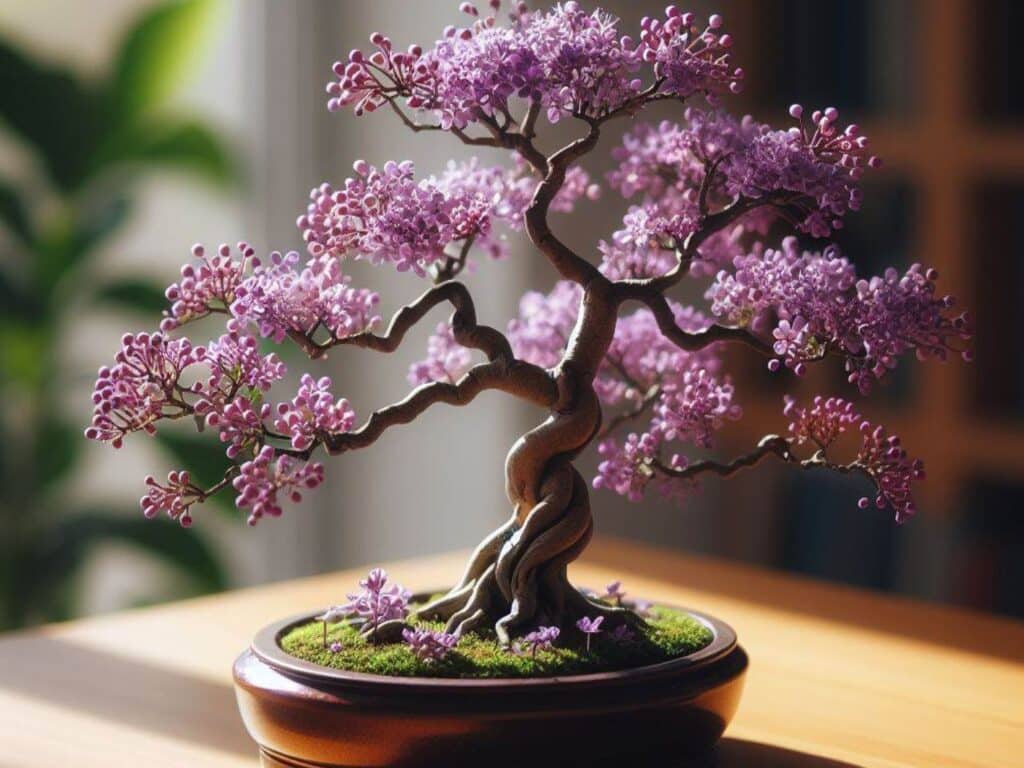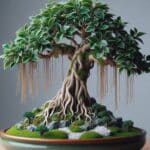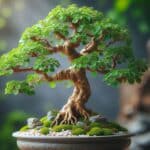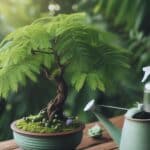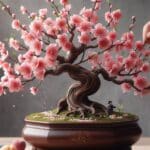There are many great reasons to want a bonsai tree with purple flowers.
This might be your favorite color or perhaps you love the soothing effect this bright feminine color can have on interior spaces.
Some bonsai enthusiasts prefer this flower color because it is associated with wisdom and creativity, while others grow it because purple is often associated with royalty, power, and luxury.
You may want a purple bonsai for any of these reasons, or you may want it for all the reasons we mentioned here. In any case, you will always be happy growing this type of bonsai tree.
If you want to add a purple flowering bonsai to your collection, it is best to watch for the following tree species.
10 Most Eye-Catching Purple Bonsai Trees
There are quite a few different species of trees that produce purple flowers. While most of these species can successfully be turned into bonsai, the growing journey will differ for each species because they have different growing needs. Let’s look at some of the most impressive purple flowering bonsais you can consider if you want to include this optimistic shade in your home or garden.
Purple Bougainvillea Bonsai

Bougainvilleas (Bougainvillea Spp.) come in various colors, including purples, pinks, oranges, reds, and white. There are several different purple bougainvillea varieties, including some with variegated leaves. New River, Texas King, Espinosa, and Formosa are some of the most popular purple bougainvillea varieties to consider if you want to grow your purple bonsai.
Bonsai beginners adore these shrubs because they are among the easiest flowering trees to bonsai, and you can grow them into any of the popular bonsai tree shapes.
This fast-growing plant is quick to grow and shape. With the right care, you can grow a beautiful flowering bonsai from a simple cutting in just a couple of months, and these trees can live up to 10 years.
The trees are also pretty easy to grow and care for since they are drought-tolerant and respond well to hard pruning. However, they require higher temperatures during their growing season and rely on a cold dormancy stage for winter. They should be protected from frost in extremely cold regions.
Chinese Fringe Bonsai

The Chinese fringe flower (Loropetalum Chinese) is a popular shrub in ornamental gardens because it can be used to create all sorts of showy borders. This shrub can also be trained into bonsai form. The mini Chinese fringe flower can look charming with its dark foliage and wispy purple flowers.
This type of bonsai prefers full sun to partial shade, meaning it should grow well in a sunny window with about 6 hours of direct sunlight.
This bonsai can be tricky to care for since extremely hot or cold temperatures can damage it. This flowering plant requires more regular watering and pruning than bougainvilleas, or they will quickly revert into shrub form. It is a pretty easy bonsai to grow and a good option if you enjoy regularly pruning your mini trees.
Lavender Wisteria Bonsai
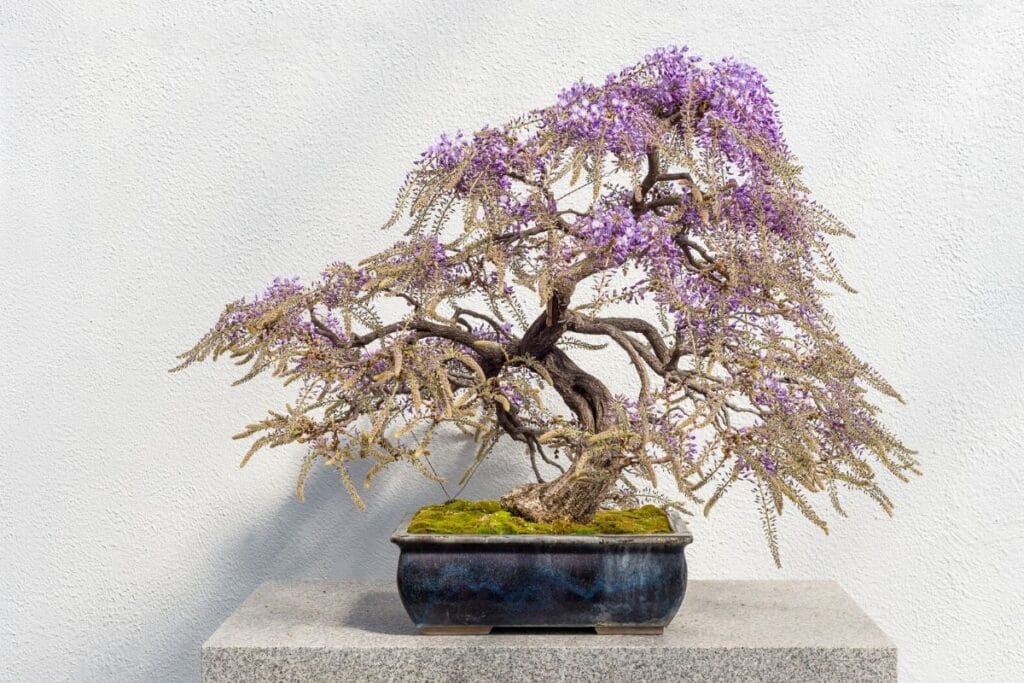
Wisteria (Wisteria Floribunda) trees can be used to create some of the most beautiful and whimsical bonsais. When they are in full bloom, they produce long flower blossoms that droop down from the tree. This can give the tree a weeping appearance.
This plant species is well suited for medium to large-sized bonsai because they need a bit of height for the long flower clusters.
Wisteria bonsais love plenty of sunlight and should be kept outdoors during summer. They are frost-tolerant and can withstand extreme temperatures, but the roots should be protected during icy winter days.
These mini deciduous trees are quite thirsty during the growing season and they can grow quite vigorously. A wisteria seedling can be ready for repotting after just one growing season and will quickly mature into a bonsai tree with a more aged appearance.
Lavender Star Flower Bonsai

The lavender star flower (Grewia occidentalis) is the crossberry. This small tree or evergreen shrub originates from Africa and is often used in bonsai creations. This plant species produces bright green foliage with small star-shaped flowers that can appear throughout the year. You might also notice small edible fruits that turn reddish brown or light purple during summer.
This small tree prefers a full-sun position, or it won’t bloom. The bonsai tree likes regular watering and prefers well-drained, moist soil during summer, while it is more drought tolerant during winter.
You can use this shrub to create various bonsai shapes, and they are very easy to prune and shape, making it popular among bonsai beginners.
Purple Smoke Bonsai Tree
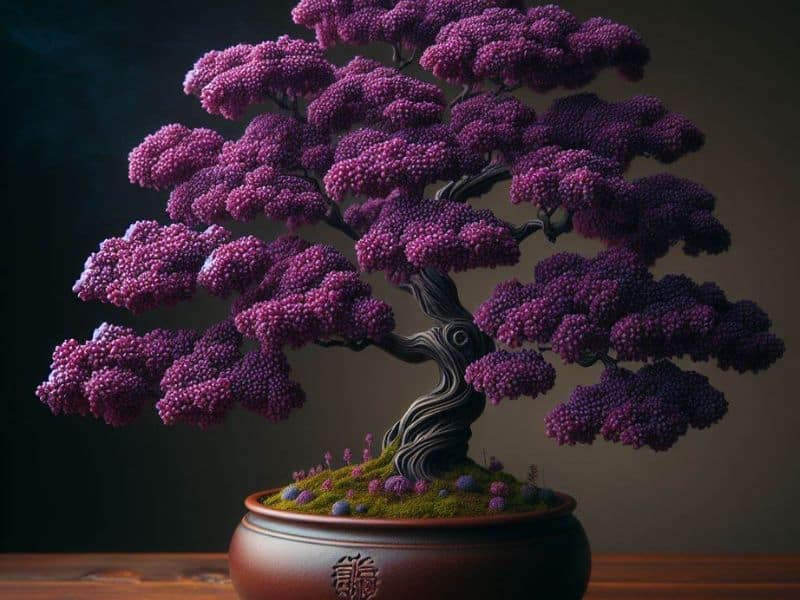
The purple smoke tree (Cotinus Coggygria Purpureus) isn’t one of the easiest plants to come by, but it can make quite an interesting bonsai. This specific variety produces large purple or pinkish blooms, but it gets its name from the feathery plumes around its kidney-shaped fruits. These feathery plumes give the tree a smoky appearance.
The deciduous tree can offer year-round interest since its foliage will transform into pinkish or purplish tones during Autumn. In summer, the waxy leaves are dark green.
The smoke tree is a rapid grower, which is ideal if you want to grow a bonsai quickly and it is usually treated as an outdoor bonsai since the tree prefers lots of direct sunlight. The little tree prefers warmer temperatures and should be protected from the winter frost. This miniature tree als requires a lot of maintenance since its rapidly growing foliage will need to be pruned and trimmed throughout the year.
Amethyst Azalea

The amethyst azalea (Rhododendron Ámethyst’) is suitable for bonsai purposes. This species produces evergreen foliage with bright purple blooms that can be enjoyed for up to three seasons. The purple flowers of this miniature tree are quite impressive since the trees tend to bloom excessively.
Azalea bonsai trees are some of the most popular flowering bonsai species. They are mostly kept outdoors but can also make good indoor bonsai if you place them in a window with lots of early morning or late afternoon sunlight.
This purple flowering bonsai requires regular watering and fertilizer. It can be challenging to shape and train because the branches of the tree are brittle and can easily snap or break during manipulation.
Purple Princess

Purple Princess (Lagerstroemia Indica ‘Purple Princess’), commonly known as the crepe myrtle, is another excellent plant for bonsai creations. This variety of crepe myrtle will offer year-round interest because it will produce vivid purple blooms on the branch tips during spring.
The foliage of this deciduous tree will also transform into bright orange tones when it starts dying back for the colder months. The small tree also looks attractive during winter because it has an interesting bark pattern and a dense branch structure.
This little tree requires quite a bit of maintenance since it prefers moist, well-drained soil and hard pruning at the end of the summer season.
Jacaranda Bonsai

Jacaranda bonsai trees (Jacaranda mimosifolia) are quite interesting because the leaves of this tree have a fern-like pattern. The foliage will stay on the tree in warmer temperatures throughout the winter.
This tree is most impressive during springtime when it produces vivid purple blooms.
Since Jacaranda bonsai prefers warmer and sunny temperatures, it is usually best to keep it outdoors in a sunny or semi-shade position during the warmer months and to bring it indoors for winter. These little trees are very sensitive to cold and should always be protected during lower temperatures.
This purple bonsai isn’t the easiest to care for since it requires regular watering but it can also be sensitive to over-watering. These slow-growing trees need to be strongly pruned during spring, and their long leaves also need to be shortened throughout the growing season since the foliage can quickly become too large.
Purple Orchid Bonsai
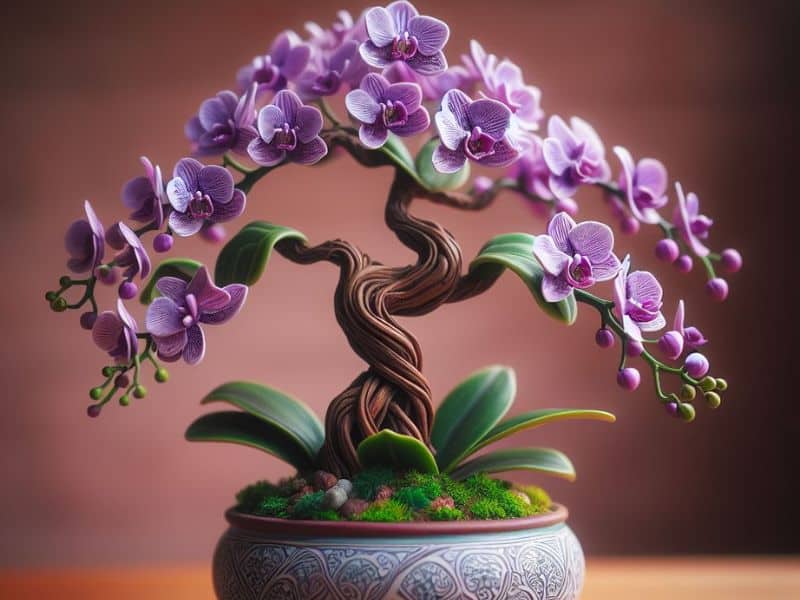
The purple orchid tree (Bauhinia purpurea) is also a very good species to use for bonsai. This flowering tree produces vivid purple flowers with five petals that can look quite interesting.
Purple orchid trees are rare in bonsai form because they have larger leaves of about 10 – 20 centimeters, making the tree look off-balance. However, this tree’s heart shape can give your bonsai a very interesting appearance.
This semi-evergreen tree should be kept in a sunny position or it might not flower. The small tree prefers frequent but deep waterings but shouldn’t be over-watered since it is semi-drought tolerant. This tree species is known for its fast growth and should be pruned regularly to maintain its shape.
Purple Hibiscus Bonsai

Hibiscus trees (Hibiscus rosa-sinensis) can also be used for medium to large-sized bonsai and there are quite a few purple hibiscus varieties that produce showy purple flowers such as the Paraplu Violet Hibiscus, Marina Purple Hibiscus, and Blue Bird Purple Hibiscus.
While the flowers of this tree can be quite showy due to their intense color and size, the number of blooms on your tree will be quite restricted. In most cases, you will likely only be able to enjoy a few blooms at a time.
This type of miniature tree requires regular watering and pruning. A lot of caution should be exercised during pruning and shaping because the branches can easily break. Bonsai enthusiasts also need to be careful to remove a bit of foliage throughout the growing season since the leaves of this tree tend to be quite large.
Final Thoughts
Purple bonsai trees are usually a pretty rare find but this is exactly what makes them so extraordinary. These miniature trees with their bright purple blooms will certainly captivate the attention of anyone who lays eyes on them and they are wonderful for enhancing the aesthetics of your garden or interior spaces.
We hope that this guide made it a little bit easier for you to find a purple flowering bonsai that you can add to your tree collection. We also wish you the best while growing this type of tree and hope that you will soon have lots of vivid purple flowers that can brighten up your day.

